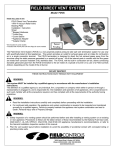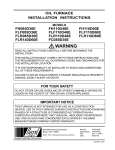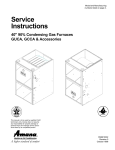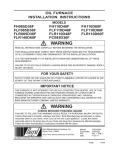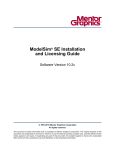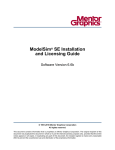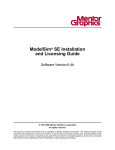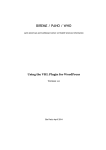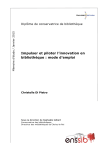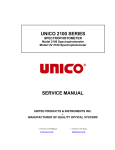Download Bard FH110D60D Operating instructions
Transcript
OIL FURNACE INSTALLATION INSTRUCTIONS MODELS FH085D36D FLF085D36D FLR110D48D FH110D48D FLR085D36D FLR140D60D FH110D60D FLF110D48D FC085D36D WARNING READ ALL INSTRUCTIONS CAREFULLY BEFORE BEGINNING THE INSTALLATION. THIS INSTALLATION MUST COMPLY WITH THESE INSTRUCTIONS AND THE REQUIREMENTS OF ALL GOVERNING CODES AND ORDINANCES FOR THE INSTALLATION LOCATION. IT IS THE RESPONSIBILITY OF INSTALLER TO KNOW AND UNDERSTAND ALL OF THESE REQUIREMENTS. FAILURE TO DO SO COULD CREATE A HAZARD RESULTING IN PROPERTY DAMAGE, BODILY INJURY OR DEATH. FOR YOUR SAFETY DO NOT STORE OR USE GASOLINE OR OTHER FLAMMABLE VAPORS OR LIQUIDS IN THE VICINITY OF THIS OR ANY OTHER APPLIANCE. IMPORTANT NOTICE THIS FURNACE IS NOT INTENDED FOR USE AS A CONSTRUCTION HEATER. USE OF THIS FURNACE DURING CONSTRUCTION AND FINISHING PHASES OF A STRUCTURE IS CONSIDERED AS "OPERATION IN A CORROSIVE ATMOSPHERE" AND "UNUSUAL, NEGLIGENT OR IMPROPER USE" AND AS SUCH ARE CONSIDERED EXCLUSIONS BY THE BARD MANUFACTURING COMPANY LIMITED WARRANTY. Bard Manufacturing Company Bryan, Ohio 43506 Since 1914...Moving ahead just as planned. Manual: Supersedes: File: Date: 2100-392 VOL. I, TAB 3 08-06-01 Copyright 2001 CONTENTS Getting Other Information and Publications Installation and Operating Instructions Equpment Selection ............................................... 2 Locating the Furnace .............................................. 2 Duct Work ............................................................... 6 Wiring ............................................................... 6 Oil Line Piping ........................................................ 8 Beckett AFG Oil Burner .......................................... 8 Beckett “CleanCut” Oil Pump ................................. 9 Beckett Solid State Igniter ...................................... 9 Beckett R7184B Primary Control ............................ 9 Beckett R7184B Primary Operational Guide ........ 10 Burner Set up and Adjustments ........................... 11 Burner Nozzle and Electrode Adjustments ........... 14 Ventilation and Combustion Air ............................ 14 Louvers and Grilles ............................................... 18 Venting ............................................................. 18 Thermostat ........................................................... 18 Fan & Limit Control ............................................... 18 TABLES Table 1 Table 2 Table 3 Table 4 Table 5 Table 6 Table 7 Table 8 Table 9 Table 10 Table 11 Table 12 Table 13 Table 14 i Minimum Clearances ............................. 2 Dimensions Lo-Boy Models .................. 3 Dimensions Hi-Boy Models .................... 4 Dimensions Counterflow Models ............ 5 Electrical Data ........................................ 7 Furnace Data ........................................ 11 Correlation of % of CO2, O2 and Reserve Air .......................................... 13 No. 2 Fuel Oil Efficiency Chart ............. 13 Recommended Start-Up Settings ........ 13 Round Duct Sizing ............................... 14 Sq.Ft. Required as Unconfined Space ................................ 15 Minimum Ventilation Openings ............. 16 Temperature Rise Ranges, Limit Control Settings, and Heating Blower Speeds ........................ 19 Filter Sizes for Gas Furnaces ............... 20 Filters Hi-Boy Models – Filter Locations & Removal and Replacement Procedures .............................. 20 Counterflow Models – Filter Locations ............... 21 Lo-Boy Models – Filter Locations ....................... 22 Maintenance Lubrication ............................................................ 23 Inspect Air Filter .................................................... 23 Final Inspeciton and Test ...................................... 23 Service Hints ........................................................ 23 Combination Combustion Chamber/Burner Mounting System .................................................. 24 To Remove Burner Only ....................................... 24 To Remove Entire Combustion Chamber Mounting System .................................................. 24 Common Causes of Trouble ................................. 26 Care of Finish ....................................................... 26 Cleaning of Furnace ............................................. 26 Blower System Resistance Curves ................ 27-30 Wiring Diagrams ............................................. 31-33 FIGURES Figure 1 Figure 2 Figure 3 Figure 4 Lo-Boy Models Dimensions ............... 3 Hi-Boy Models Dimensions ................ 4 Counterflow Models Dimensions ....... 5 Typical Installation Requirement Front Flue .......................................... 7 Figure 5 Typical Single Inside Tank Installation ................................. 8 Figure 6 Pressure Gauge Connection to Pressure Gauge Port ....................... 12 Figure 7 Electrode Adjustments ..................... 14 Figure 8 All Air From Inside Building .............. 15 Figure 9 All Air From Outdoors ...................... 16 Figure 10 All Air From Outdoors Through Ventilated Attic ................................. 17 Figure 11 All Air From Outdoors - Inlet Air From Ventilated Crawl Space and Outlet Air to Ventilated Attic ............. 17 Figure 12 Typical Installation of 16x25x1 Filter Rack ........................................ 20 Figure 13 Typical Installation of 20x25x1 Filter Rack ........................................ 20 Figure 14 Filter Installation - Counterflow Models ............................................. 21 Figure 15 Filter Installation - Lo-Boy Models ... 24 Figure 16A Removal of Burner Only .................. 20 Figure 16B Removal of Entire Combustion Chamber Mounting System ............. 25 GETTING OTHER INFORMATION and PUBLICATIONS These publications can help you install the furnace. You can usually find these at your local library or purchase them directly from the publisher. Be sure to consult current edition of each standard. FOR MORE INFORMATION, CONTACT THESE PUBLISHERS: ACCA Air Conditioning Contractors of America 1712 New Hampshire Ave. N.W. Washington, DC 20009 Telephone: (202) 483-9370 Fax: (202) 234-4721 ANSI American National Standards Institute 11 West Street, 13th Floor New York, NY 10036 Telephone: (212) 642-4900 Fax: (212) 302-1286 ASHRAE American Society of Heating Refrigerating, and Air Conditioning Engineers, Inc. 1791 Tullie Circle, N.E. Atlanta, GA 30329-2305 Telephone: (404) 636-8400 Fax: (404) 321-5478 NFPA National Fire Protection Association Batterymarch Park P.O. Box 9101 Quincy, MA 02269-9901 Telephone: (800) 344-3555 Fax: (617) 984-7057 National Fuel Gas Code ........... ANSI Z223.1/NFPA54 National Electrical Code ...................... ANSI/NFPA 70 Standard for the Installation .............. ANSI/NFPA 90A of Air Conditioning and Ventilating Systems Standard for Warm Air ...................... ANSI/NFPA 90B Heating and Air Conditioning Systems Standard for Chimneys, Fireplaces, Vents ... NFPA 211 and Solid Fuel Burning Appliances Load Calculation for .......................... ACCA Manual J Residential Winter and Summer Air Conditioning Duct Design for Residential .............. ACCA Manual D Winter and Summer Air Conditioning and Equipment Selection Manual 2100-392 Page 1 INSTALLATION and OPERATING INSTRUCTIONS EQUIPMENT SELECTION LOCATING THE FURNACE An accurate heating load calculation must be conducted using American Society of Heating, Refrigeration and Air Conditioning Engineers (ASHRAE) or Air Conditioning Contractors of America (ACCA) manuals. Do not add a large safety factor above the calculated value. If the calculated heating load requirement exceeds the heating capacity rating of a given model, use only the next larger size available. Never increase by any more than absolutely necessary based upon available equipment heating capacities. Always select based upon heat capacity (output), never use input capacities. When installing the furnace be sure to provide adequate space for easy service and maintenance. Locate the furnace as close to the chimney as practical, giving consideration to the accessibility of the oil burner, controls, and blower for service. Allow a minimum of 24 inches at front of furnace for servicing oil burner. Allow adequate room for filter and blower maintenance. Clearance from combustible material as stated on the furnace and repeated in Table 1 must be maintained. For damp basement installations, a raised concrete pad is recommended. This will help keep the bottom of the furnace dry and reduce rusting. NOTE: It is the personal responsibility and obligation of the purchaser to contract a qualified installer to assure that installation is adequate and is in conformance with governing codes and ordinances. An oil burner must have a generous supply of combustion air to operate properly. The flow of combustion and ventilating air must not be obstructed from reaching the furnace. See “Ventilation and Combustion Air” section. The furnace area must be kept clear and free of combustible materials, gasoline and other flammable vapors and liquids. This unit is not designed for mobile home or trailer installations. Always install furnace in a level position. TABLE 1 MINIMUM CLEARANCES Minimum Installation Clearances - - Inches Furnace Plenum 1 Minimum Service Clearances Front B ack Sides Top Sides D u ct Flue Pipe Floor Front B ack Sides FH085D36D FH110D48D FH110D60D 4 4 4 1 1 1 2 2 2 2 2 2 2 2 2 2 2 2 9 9 9 C C C 24 24 24 ------- ------- F LF 085D 36D FLR085D36D FLF110D48D 6 6 6 0 18 0 2 2 2 2 2 2 2 2 2 2 2 2 9 9 9 NC NC NC 24 24 24 24 24 24 18 * 18 * 18 * FLR110D48D FLR140D60D F C 085D 36D 6 6 6 18 18 1 2 2 2 2 2 2 2 2 2 2 2 2 9 9 9 NC NC NC ** 24 24 24 24 24 --- 18 * 18 * --- Model j C NC * ** For the first three (3) feet from plenum. After three (3) feet, no clearance required. Combustible flooring Noncombustible floor Maintained on one side or the other to achieve filter access and/or blower service. Floor must be noncombustible. For furnace only installation can be installed on combustible flooring only when installed on special base part no. CFB7 available from factory. When air conditioning coil cabinet DCB23-22 is used then use special base part no. CFB23. Manual 2100-392 Page 2 TABLE 2 LO-BOY MODELS DIMENSIONS (INCHES) Plenum Openings Cabinet Model Number A Width B Depth C DxE Height Supply DxF Return G Dia. H Location F LF 085D 36D FLR085D36D 23 23 47-1/4 47-1/4 40-1/4 40-1/4 22x20 22x20 22x16 22x16 Front Rear 6 6 --34 FLR110D48D FLR110D48D 23 23 47-1/4 47-1/4 44-1/4 44-1/4 22x20 22x20 22x16 22x16 Front Rear 6 6 FLR140D60D 26 50 50 25x20 25x16 Rear 6 j Air Filters 1 Flue Connection J Siz e N o. U sed 5-1/4 --- 16 x 20 x 1 16 x 20 x 1 1 1 --38 5-1/4 --- 20 x 20 x 1 20 x 20 x 1 1 1 43-5/8 --- 20 x 25 x 1 1 Washable type filter 1” nom. thickness FIGURE 1 LO-BOY MODELS DIMENSIONS MIS-1345 Manual 2100-392 Page 3 TABLE 3 HI-BOY MODELS DIMENSION (INCHES) Cabinet Model Number FH085D36D FH110D48D FH110D60D Plenum Openings A Width B Depth C Height DxE Supply FxH 2 Return G Flue Dia. Filter Siz e 23 23 23 31-1/2 31-1/2 31-1/2 56 60 60 22x20 22x20 22x20 23x14 23x14 23x14 6 6 6 16 x 25 16 x 25 20 x 25 j k 1 Washable type filter Left or right side return air option. Must be cut in by installer. FIGURE 2 HI-BOY MODELS DIMENSIONS MIS-1346 Manual 2100-392 Page 4 TABLE 4 COUNTERFLOW MODELS DIMENSION (INCHES) Cabinet Plenum Openings Model Number A Width B Depth C Height DxE2 Return FxH Supply G Flue Dia. F C 085D 36D 23 29-1/2 56 22 x 20 18 x 19 6 j k 1 Filter Siz e 10 x 20 15 x 20 Washable type filter Left or right side return air option. Must be cut in by installer. FIGURE 3 COUNTERFLOW MODELS DIMENSIONS MIS-1344 Manual 2100-392 Page 5 DUCT WORK The air distribution system should be designed and installed in conformance with manuals published by Air Conditioning Contractors of America (ACCA) as set forth in Manual D, or ASHRAE publications. On replacement installations, particularly if equipment is oversized, the duct systems can easily be undersized. Modifications may be required to assure that the equipment is operating within the approved temperature rise range when under full rated input conditions, and that no short cycling on limit controls is occurring. IMPORTANT When a furnace is installed so that supply ducts carry air circulated by the furnace to areas outside the space containing the furnace, the return air must also be handled by a duct(s) sealed to the furnace casing and terminating outside the space containing the furnace This is to prevent drawing possible hazardous combustion products into the circulated air. When the furnace is used in connection with a cooling unit*, the furnace shall be installed parallel with or on the upstream side of the cooling unit to avoid condensation in the heating element. With a parallel flow arrangement, the dampers or other means used to control flow of air shall be adequate to prevent chilled air from entering the furnace, and if manually operated, must be equipped with means to prevent operation of either unit, unless the damper is in the full heat or cool position. * A cooling unit is an air conditioning coil, heat pump coil or chilled water coil. See CFM versus static pressure tables on pages 23-26 for additional information. INADEQUATE SUPPLY AIR and/or RETURN AIR DUCT SYSTEMS Short cycling because of limit control operation can be created by incorrectly designed or installed supply and/ or return air duct systems. The duct systems must be designed using ASHRAE or ACCA design manuals and the equipment CFM and external static pressure ratings to insure proper air delivery capabilities. Manual 2100-392 Page 6 INSTALLING THE FURNACE A typical installation is shown in Figure 4. All parts of the furnace installation (furnace, oil tank and piping systems, combustion and ventilation air, venting, etc.) must comply with NFPA31, Installation of Oil Burning Equipment -- latest edition. This drawing shows the typical connecting parts needed to correctly install this furnace. Make sure that all parts of the heating system comply with the local codes. Check the furnace and your load calculation to verify that the unit is properly sized. (Refer to Equipment Selection” section on Page 2.) The correct size of unit needed may be substantially smaller than the unit being replaced due to home improvements and technology advancements since the initial installation. WIRING FACTORY All units are fully factory wired. Multispeed blowers are factory wired on high speed for cooling/manual fan operation. Heating speeds are wired for the largest input and may need lower speed for field installed low input nozzle. If replacement wire is necessary, use 105 degrees C minimum. See electrical data, Table 5. FIELD All wiring must conform to the National Electrical Code and all local codes. A separate fuse or breaker should be used for the furnace. FIGURE 4 TYPICAL INSTALLATION REQUIREMENTS FRONT FLUE LO-BOY MODEL SHOWN MIS-1335 NOTE: The chimney must be lined with a high temperature noncorrosive material that complies with the local codes, or in their absence with Standard for Chimneys and Vents, NFPA211. Also see section on Venting in these instructions. TABLE 5 ELECTRICAL DATA Blow er Motor Burner Motor Max. Time Delay Fuse or HACR Circuit Breaker Model Volts-HZ-PH Total Amps HP FLA HP FLA Minimum Circuit Ampacity FH085D36D 115-60-1 9.2 1/3 7.5 1/7 1.7 15 15 FH110D48D 115-60-1 12.2 1/2 10.5 1/7 1.7 16 20 FH110D60D 115-60-1 14.2 3/4 12.5 1/7 1.7 19 20 F LF 085D 36D 115-60-1 17.3 1/3 5.6 1/7 1.7 15 15 FLR085D36D 115-60-1 17.3 1/3 5.6 1/7 1.7 15 15 FLF110D48D 115-60-1 12.2 1/2 10.5 1/7 1.7 16 20 FLR110D48D 115-60-1 12.2 1/2 10.5 1/7 1.7 16 20 FLR140D60D 115-60-1 14.2 3/4 12.5 1/7 1.7 19 20 F C 085D 36D 115-60-1 7.3 1/3 5.6 1/7 1.7 15 15 Manual 2100-392 Page 7 OIL LINE PIPING First determine whether the pipe system is to be a single line system or a two line system. All connections must be absolutely air tight or you will have a malfunction of the burner. When installing the piping, a good oil filter should be installed close to the burner. A single line system is recommended for gravity feed. A typical single inside tank installations shown in Figure 5. For installation details for this and other tank configurations, refer to NFPA31 -- latest edition. All tank and pipe setups must comply with NFPA31. These controls were selected for their proven high quality, dependability, and serviceability. With proper maintenance this burner assembly will provide many years of reliable service. All units are shipped with the oil burner installed, and with high rate oil nozzle installed designed for use with No. 1 or No. 2 fuel oil. Inspect firepot refractory before firing to be sure it has not been jarred out of position in shipment. Burner air tube must not extend beyond inside surface of firepot. Burner head should be centered on the combustion chamber opening. See Figures 16A and 16B. BECKETT AFG OIL BURNER This furnace is equipped with a high static Beckett AFG oil burner which is designed to produce adequate draft in nearly any vertically vented application. The burner employees the latest time tested controls of the highest quality. The controls consist of a high voltage Beckett solid state igniter, a Beckett “CleanCut” oil pump with an integral solenoid valve, and a Beckett R7184B primary control. WARNING Never attempt to use gasoline in your furnace. Gasoline is more combustible than fuel oil and could result in a serious explosion causing damage, injury or death. FIGURE 5 TYPICAL SINGLE INSIDE TANK INSTALLATION MIS-1340 Manual 2100-392 Page 8 The following is a detailed explanation of each control included in the Becket AFG Oil Burner, how each operates, how to set up the burner, and how to troubleshoot problems should they occur. BECKETT “CLEANCUT” OIL PUMP This oil pump is equipped with an oil solenoid valve installed in the pump housing. This feature provides quick cutoffs resulting in reduction in smoke after the burner shuts down. This is a time proven pump design and is capable of both one and two pipe systems. This pump requires a pre-purge style primary control such as the R7184B primary. All installation and set up instructions are outlined in the “Oil Pump Specification” section of the installation instructions manual. As an improved service feature Bard Manufacturing has installed a brass tee fitting next to the oil line output of the pump for installing a pressure gauge to ensure the correct pump pressure. Refer to the “Burner Set Up and Adjustment” section in the manual. BECKETT SOLID STATE IGNITER This igniter differs from the traditional iron core transformer in that it produces a 14,000 volt spark instead of a 10,000 volt spark of the iron core transformer. This hotter spark provides for cleaner, faster ignitions. Being solid state technology this igniter is less susceptible to problems caused by voltage variations. It also has a greater ability to ignite cold and/or inconsistent oil. The solid state igniter is wired to the primary control the same as a standard iron core transformer. BECKETT R7184B PRIMARY CONTROL The R7184B Interrupted Electronic Oil Primary is a line voltage, safety rated, interrupted ignition oil primary control for residential oil burners. The R7184B used with a cad cell flame sensor, operates the oil burner and oil valve. The primary controls fuel oil, senses flame, controls ignition spark and is designed to notify a remote alarm circuit before going into lockout when equipped with a flame monitoring system. This primary control, though it possesses the latest technology, is a very simple control to operate and provides additions troubleshooting features to ease service and reduce down time. Once the features and operation of this control are understood the service person will find it a welcomed addition. In an effort to help in the transition to the R7184B primary control the operational guide is provided following on Page 10. Manual 2100-392 Page 9 BECKETT R7184B PRIMARY OPERATIONAL GUIDE Pre-Purge Delay – 15 seconds on delay LED Codes – Flashing 1/2 second on / 1/2 second off – system is locked out or in restricted mode (hard lockout). – Flashing 2 seconds on / 2 seconds off – control is in recycle mode (soft lockout). – ON – CAD cell is sensing flame – OFF – CAD cell is not sensing flame. Ignition Trials – On any given call for heat the control will allow three ignition trials. After the three trials the control will go into a soft lockout mode. The LED will flash 2 seconds on and 2 seconds off when in this recycle mode. The control may then be reset by pressing the RED reset button on the control. If within the same original call for heat the control will again allow three ignition trials followed by another soft lockout and a 2 second on / 2 second off LED code. The control my be reset one additional time by pressing the red reset button. This will allow three final ignition trials. If all three of the final ignition trials fail then the control goes into a hard lockout or Restricted Mode. This series of ignition failures must all occur with the original call for heat in order to reach the Restricted Mode. The LED will now flash 1/2 second on / 1/2 second off indicating the restricted mode. The control can be resurrected from the restricted mode only by pressing and holding the red reset button for approximately 30 seconds until the LED flashes twice. Removing unit power or resetting the thermostat will not reset the control Checking CAD Cell – With a call for heat and the burner ignited, press and release the red reset button. The LED will go out and then flash 1, 2, 3, or 4 times before returning to the run mode. The CAD cell resistance must be below 1600 ohms for proper operation. – 1 flash – Less than 400 ohms – 2 flashes – More than 400 and less than 800 ohms – 3 flashes – More than 800 and less than 1600 ohms – 4 flashes – More than 1600 and less than 5000 ohms Future Option – Flame Quality Monitor This control is trained to recognize and remember a good flame based on initial burner set up. Control then monitors the flame via the CAD cell signal for deviation in the combustion characteristics of the burner. If the control senses a deviation on the high side or on the low side from the original set up condition for three consecutive cycles, it will trigger an alarm circuit which can be tied to an audible local device to signal the home owner or into the home security Manual 2100-392 Page 10 system. Upon being notified of the of the alarm, the security agency will notify the dealer of choice based upon information supplied by the home owner. The system will also be capable of being connected to a phone line that will contact the dealer directly with the alarm. This alarm will typical sound 3 to 5 days prior to the primary control going into lockout giving the service agency a prior notice before a sooting condition or other failure can occur resulting in untold savings. TABLE 6 FURNACE DATA Furnace Installed Standard 2 1 Field Installed Option 2 1 Model Number Noz z le Siz e Input B TU H Heating Capacity B TU H F LF 085D 36D .75 105,000 85,000 .65 91,000 75,000 FLR085D36D .75 105,000 85,000 .65 91,000 75,000 FLF110D48D 1.00 140,000 115,000 .85 119,000 98,000 FLR110D48D 1.00 140,000 115,000 .85 119,000 98,000 FLR140D60D 1.25 175,000 141,000 1.10 154,000 125,000 F C 085D 36D .75 105,000 84,000 .65 91,000 74,000 FH085D36D .75 105,000 84,000 .65 91,000 74,000 FH110D48D 1.00 140,000 113,000 .85 119,000 96,000 FH110D60D 1.00 140,000 113,000 .85 119,000 96,000 j k Noz z le Siz e Input B TU H Heating Capacity B TU H 70 degree hollow cone spray pattern, 100 PSIG pump pressure Annual fuel utilization efficiency and heating capacity based upon U.S. Government standard test using D.O.E. isolated combustion rating procedure. BURNER SETUP AND ADJUSTMENTS All oil burner installations should be performed by a qualified installer in accordance with regulations of the National Fire Protection Standard for Oil-Burning Equipment, NFPA31 -- latest edition, and in complete compliance with all local codes and authorities having jurisdiction. A qualified installer is an individual or agency who is responsible for the installation and adjustments of the heating equipment and who is properly licensed and experienced to install oil-burning equipment in accordance with all codes and ordinances. The proper installation and adjustment of any oil burner requires technical knowledge and the use of combustion test instruments. The following procedure must be followed to correctly adjust the burner to match the specific characteristics of the installation. IMPORTANT Always use combustion test instruments when making burner adjustments and draft gauge when setting the barometric damper. It is virtually impossible to make accurate and reliable adjustments using the “eyeball” method. CHECK AND ADJUSTMENT PROCEDURE: 1. Check all oil lines and connections for leaks. 2. Connect pressure gauge to pressure gauge port in brass tee fitting. See Figure 6. 3. Operate the burner for 5 - 10 minutes so that the system is near steady state temperature conditions. 4. Check fuel pump pressure, and adjust to 100 PSIG if necessary. 5. Set the overfire draft to -.02” W.C. by adjusting the barometric damper. The sample tube can be inserted into the heat exchanger over the combustion chamber by loosening the two (2) screws securing the sliding door on the hinged burner observation door. 6. A small diameter hole will be required in the flue pipe between the flue connection on the furnace and the barometric damper for purposes of taking the smoke tests and measuring the CO2 (or O2) and flue gas temperature. 7. The burner air adjustment shutters are factory set to the recommended start up settings as shown in Table 9. These settings are for initial start up only. Reduce or increase the air supply until a trace of smoke is obtained on the smoke tester. This is a reference point only not the final adjustment. Manual 2100-392 Page 11 8. Measure the CO2 (or O2) in the flue gas at the trace of smoke level. Open the air control and add reserve air until the CO2 is lowered by 1.5%. Example: Original CO2 at trace of smoke level was 13.0% (3.30% O2). Lower to 11.5% CO2 (5.3% 02). See Table 7. 9. Perform the smoke test again. It should now be at zero. Lock the air settings securely. 10. Measure the stack temperature. Subtract the room temperature to obtain the net reading and use the Efficiency Chart, Table 8, to determine the steadystate efficiency. FIGURE 6 PRESSURE GAUGE CONNECTION TO PRESSURE GAUGE PORT MIS-1660 Manual 2100-392 Page 12 TABLE 7 CORRELATION OF PERCENT OF CO2, O2 AND RESERVE AIR Carbon Dioxide Oxygen Reserve Air (Approx.) 15.4 15.0 14.5 0.0 0.6 1.2 0.0 3.0 6.0 14.0 13.5 13.0 2.0 2.6 3.3 10.0 15.0 20.0 12.5 12.0 11.5 4.0 4.6 5.3 25.0 30.0 35.0 11.0 10.5 10.0 6.0 6.7 7.4 40.0 45.0 50.0 TABLE 8 NO. 2 FUEL OIL EFFICIENCY CHART (NET STACK TEMP. DEGREES F) % O2 200 250 300 350 400 450 500 550 600 650 700 750 800 % O2 1 89.6 88.4 87.3 86.2 85.1 84.0 82.9 81.7 80.6 79.5 78.4 77.3 76.2 14.7 2 89.4 88.2 87.0 85.9 84.7 83.6 82.4 81.2 80.1 78.9 77.7 76.6 75.4 14.0 3 89.2 87.9 86.7 85.5 84.3 83.1 81.9 80.7 79.4 78.2 77.0 75.8 74.6 13.2 4 88.9 87.7 86.4 85.1 83.8 82.6 81.3 80.0 78.7 77.5 76.2 74.9 73.6 12.5 5 88.7 87.3 86.0 84.6 83.3 82.0 80.6 79.3 77.9 76.6 75.3 73.9 72.6 11.7 6 88.4 87.0 85.5 84.1 82.7 81.3 79.9 78.5 77.0 75.6 74.2 72.8 71.4 11.0 7 88.0 86.5 85.0 83.5 82.0 80.5 79.0 77.5 76.0 74.5 73.0 71.5 70.0 10.3 TABLE 9 RECOMMENDED START-UP SETTINGS Factory Installed 1 Field Installed Option 1 Furnace Model No. Burner Style Part No. Noz z le Air Band Setting Air Shutter Setting Noz z le Air Band Setting Air Shutter Setting FH085D36D AFG/9020-026 .75 0 6 .65 0 5 FH110D48D AFG/9020-027 1.00 2 10 .85 0 8 FH110D60D AFG/9020-027 1.00 2 10 .85 0 8 F LF 085D 36D AFG/9020-026 .75 0 6 .65 0 5 FLF110D48D AFG/9020-027 1.00 2 10 .85 0 8 FLR085D36D AFG/9020-028 .75 0 6 .65 0 5 FLR110D48D AFG/9020-029 1.00 2 10 .85 0 8 FLR140D60D AFG/9020-030 1.25 0 8 1.10 0 6 F C 085D 36D AFG/9020-026 .75 0 6 .65 0 5 j 70 degree hollow cone spray pattern, 100 PSIG pump pressure Manual 2100-392 Page 13 BURNER NOZZLE AND ELECTRODE ADJUSTMENTS Check nozzle size as to conformance to installation requirements. Install nozzle by screwing into hexagon adapter. Refer to recommended start-up setting in Table 9. SPACING OF ELECTRODES The electrodes should be spaced 5/32” apart. They should extend 1/16” beyond the end and 5/16” above the center of the nozzle tip as shown in Figure 7 GUN ASSEMBLY ADJUSTMENT The gun assembly can be adjusted in the slot inside of fan housing by loosening screw holding slot cover in position. Nozzle tip should ordinarily be located 1-1/8” behind the front face of the cone. REMOVING GUN ASSEMBLY VENTILATION AND COMBUSTION AIR Appliances shall be installed in a location where the facilities for ventilation permit satisfactory combustion of oil, proper venting and the maintenance of ambient temperature at safe limits under normal conditions of use. Applications shall be located in such a manner as to not interfere with proper circulation of air within the confined space. When building are so tight that normal infiltration does not meet air requirements, outside air shall be introduced. Ducts used to convey air from the outdoors shall be of the same cross-sectional area as the free area of the opening to which they connect. The minimum dimensions of rectangular air ducts shall be not less than 3 inches (76 mm). See Table 10 for information on round duct sizing. For residence-type installations and similar usages, the requirements normally may be obtained by application of one of the methods shown in Figures 8 thru 11 following. Disconnect the oil line at the fan housing and remove lock nuts on copper tube fitting. Loosen igniter hold down clamps, then swing igniter up and backward. Gun assembly can now be removed through this opening. TABLE 10 ROUND DUCT SIZING 4,000 BTUH Per Square Inch Round Duct Siz e Total B TU H Input 4-3/8 5-1/8 60,000 80,000 5-1/4 5-7/8 85,000 105,000 6-1/8 6-1/4 115,000 120,000 6-3/4 6-7/8 140,000 145,000 7-1/4 8 160,000 200,000 FIGURE 7 ELECTRODE ADJUSTMENTS 1-1/8 5/32 GAP ELECTRODE 5/16 1/16 NOZZLE MIS-160 Manual 2100-392 Page 14 APPLIANCES LOCATED IN CONFINED SPACES In unconfined spaces in buildings, infiltration may be adequate to provide air for combustion, ventilation, and dilution of flue gasses. However, in buildings of unusually tight construction, additional air shall be provided using the method described under “All Air From Outdoors” in Figure 8. An unconfined space (such as an open basement) must have a minimum volume of 50 cubic feet per 1,000 BTUH of total of all appliances in area. Adjoining rooms may be counted as one area only if there are not doors between the rooms. Shown in Table 11 are the required minimum areas in square feet to qualify as an unconfined space for various total BTUH input ratings. The table is based on a room(s) with 8 foot ceiling heights. If the unconfined space is within a building having insufficient air because of tight construction, the air for combustion and ventilation shall be obtained from outdoors or from spaces freely communicating with the outdoors. Under these conditions a permanent opening or openings have a total free area of not less than one square inch per 5,000 BTU per hour (28 square inches per hour ) of total input rating of all appliances shall be provided. FIGURE 8 APPLIANCES LOCATED IN CONFINED SPACES ALL AIR FROM INSIDE THE BUILDING TABLE 11 SQUARE FEET REQUIRED TO QUALIFY AS UNCONFINED SPACE Total B TU H Input Unconfined Space Minimum Area In Square Feet 8' Ceiling Height 60,000 80,000 375 500 85,000 105,000 531 656 115,000 120,000 719 750 140,000 145,000 875 906 160,000 200,000 1000 1250 ALL AIR FROM INSIDE BUILDING The confined space shall be provided with two permanent openings, one near the top of the enclosure and one near the bottom. Each opening shall have a free area of not less than one square inch per 1,000 BTU per hour (140 square inches per gallon per hour) of the total input rating of all appliances in the enclosure freely communicating with interior areas having in turn adequate infiltration from the outside. (See Figure 8.) Also see Table 12 on the following page for specific ventilation opening requirements for the furnace only. The flow of combustion and ventilating air must not be obstructed from reaching the furnace. NOTE: Each opening shall have a free area of not less than one square inch per 1,000 BTU per hour (140 square inches per gallon per hour) of the total input rating of all appliances in the enclosure. MIS-1336 Manual 2100-392 Page 15 TABLE 12 MINIMUM VENTILATION OPENINGS Model Min. Ventilation Opening Square Inch FH085D36D Recommended Opening (2 Required) Siz e Sq. In. 240 8 x 16 128 FH110D48D 280 9 x 18 162 FH110D60D 280 9 x 18 162 F LF 085D 36D 290 8 x 19 152 FLR085D36D 290 8 x 19 152 FLF110D48D 340 9 x 19 171 FLR110D48D 340 9 x 19 171 FLR140D60D 360 9.5 x 19 180 F C 085D 36D 240 8 x 16 128 ALL AIR FROM OUTDOORS A. The confined space shall be provided with two permanent openings, one in or near the top of the enclosure and one in or near the bottom. The openings shall communicate directly, or by means of ducts with outdoors or to such spaces (crawl or attic) that freely communicate with outdoors. (See Figures 9, 10, & 11 .) B. When directly communicating with outdoors or by means of vertical ducts, each opening shall have a free area of not less than one square inch per 4,000 BTU per hour (35 square inches per gallon per hour) of total input rating of all appliances in the enclosures. If horizontal ducts are used, each opening shall have a free area of not less than one square inch per 2,000 BTU per hour (70 square inches per gallon per hour) of total input of all appliances in the enclosure. FIGURE 9 APPLIANCES LOCATED IN CONFINED SPACES ALL AIR FROM OUTDOORS NOTE: Each air duct opening shall have a free area of not less than one square inch per 2,000 BTU per hour (70 square inches per gallon per hour) of the total input rating of all appliances in the enclosure. MIS-1337 Manual 2100-392 Page 16 FIGURE 10 APPLIANCES LOCATED IN CONFINED SPACES ALL AIR FROM OUTDOORS THROUGH VENTILATED ATTIC NOTE: The inlet and outlet air openings shall each have a free area of not less than one square inch per 4,000 BTU per hour (35 square inches per gallon per hour) of the total input rating of all appliances in the enclosure. MIS-1338 FIGURE 11 APPLIANCES LOCATED IN CONFINED SPACES ALL AIR FROM OUTDOORS INLET AIR FROM VENTILATED CRAWL SPACE AND OUTLET AIR TO VENTILATED ATTIC NOTE: The inlet and outlet air openings shall each have a free area of not less than one square inch per 4,000 BTU per hour (35 square inches per gallon per hour) of the total input rating of appliances in the enclosure. MIS-1339 Manual 2100-392 Page 17 LOUVERS AND GRILLES FAN AND LIMIT CONTROL In calculating free area for above ventilation and combustion air requirements, consideration shall be given to the blocking effect of louvers, grilles, or screens protecting openings. Screens used shall not be smaller than 1/4 inch (6.3 mm) mesh and shall be readily accessible for cleaning. If the free area through a design of louver or grille is known, it shall be used in calculating the size opening required to provide the free area specified. If the design and free area is not known, it may be assumed that wood louvers will have 30-35 percent free area and metal louvers and grilles will have 60-75 percent free area. The fan and limit control is factory installed in all units. See Table 13 for factory settings. The fan on/off settings may have to be varied due to the static pressure imposed upon the system. The limit control is factory set at maximum fixed stop allowable and must not be reset. VENTING The flue pipe to the chimney must be the same size as the flue outlet of the furnace, have no reductions, be of a corrosion-resistant material, and have an upward pitch of 1/4” for every foot of horizontal run. A barometric damper is supplied with the furnace and should be installed in the flue pipe observing the instructions packaged with the damper control. The barometric damper opening must be located in the same atmospheric pressure zone as the combustion air inlet to the furnace. This furnace must not be vented into the same chimney with any solid fuel burning appliance. Masonry chimneys must be lined with a listed system or other approved material that will resist corrosion, softening, or cracking from flue gas at temperatures up to 1800° F. See Standard for Installation of Oil Burning Equipment NFPA31 and Standard for Chimneys NFPA211 for additional information. When the installation is completed, measure the air temperature in the discharge plenum and return air plenum. The temperature rise across the unit should fall within the “Rise Range” as shown in Table 13. It is normally desirable to operate in the middle of the range unless air conditioning or other installation requirements make that unfeasible. The speed of the blower may have to be either increased or decreased to obtain this temperature. The blower is equipped with a 3 or 4 speed motor to make these adjustments. The fan and limit control in the burner compartment governs the blower operation by means of two temperature selections. One lever is set at 140 degrees for example to start the blower, and the other lever is at a lower temperature, 110 degrees to stop the blower. These settings may be varied to suit the homeowner’s comfort. A greater temperature difference between settings may result in less repetition of the blower operation at the end of the heating cycle. A low “off” temperature is recommended for longer blower operation as this keeps the air of the home in more constant circulation. NOTE: On model FC085D36D the blower “on” setting is timed to assure blower operation. This blower “on” setting cannot be adjusted. THERMOSTAT NOTE: FC models do not wire directly to the primary control. See wiring diagram on Page 33. These furnaces are designed to be controlled with any 24V heating or heating/cooling thermostat. The heat/cool thermostats must be designed for independent heat/cool transformer circuits to assure that the 24V transformer built into the oil primary control does not conflict with the main furnace 24V transformer. The heat anticipator should be set at 0.20A. This is a nominal setting. The thermostat circuit should be checked to verify setting. Manual 2100-392 Page 18 IMPORTANT Do not set the blower “on” set point lever of the combination fan/limit control above 150. TABLE 13 TEMPERATURE RISE RANGES, LIMIT CONTROL SETTINGS, AND HEATING BLOWER SPEEDS Rise Ranges Heating Blow er S p eed Limit Setting On Off .65 .75 70 - 100 60 - 90 Low Med 170 170 110 110 90 90 FH110D48D .85 1.00 70 - 100 60 - 90 Low Med Low 170 170 110 110 90 90 FH110D60D .85 1.00 60 - 90 60 - 90 Low Med Low 170 170 110 110 90 90 F LF 085D 36D .65 .75 60 - 90 60 - 90 Low Med 230 230 140 140 110 110 FLF110D48D .85 1.00 60 - 90 60 - 90 Med Low Med High 230 230 140 140 110 110 FLR085D36D .65 .75 60 - 90 60 - 90 Low Med 250 250 140 140 110 110 FLR110D48D .85 1.00 60 - 90 60 - 90 Med Low Med High 240 240 140 140 110 110 FLR140D60D 1.10 1.25 60 - 90 60 - 90 Med Low Med High 220 220 140 140 110 110 F C 085D 36D .65 .75 70 - 100 60 - 90 Low Med 180 180 110 110 90 90 1 Noz z le FH085D36D Model j 70 degree hollow cone spray pattern, 100 PSIG pump pressure Manual 2100-392 Page 19 FILTERS All models are shipped with filters. See Table 14 for sizes. See following information. Hi-Boy models are supplied with an external filter rack which can be installed on either left or right side. The counterflow models require a bracket installation and final filter location projects into return air plenum attachment for furnace. See Figure 14. Refer to Figure 14 for Lo-Boy models which have filters internally mounted in blower compartment at rear of furnace. HI-BOY MODELS – FILTER LOCATIONS, & REMOVAL AND REPLACEMENT PROCEDURES 16 x 25 x 1 external filter racks are supplied as standard equipment for all FH models (20 x 25 x 1 is standard for FH110D60D model). A 14 x 23 opening is to be cut into either the left or right side of the furnace depending upon installation requirements. See Figure 12 for typical installation of a 16 x 25 x 1 filter rack centered over the 14 x 23 cutout. FIGURE 12 TYPICAL INSTALLATION OF A 16x25x1 FILTER RACK MIS-1342 Manual 2100-392 Page 20 TABLE 14 FILTER SIZES FOR OIL FURNACES Model Siz e FH085D36D Hi-Boy (1) 16x25x1 W FH110D48D Hi-Boy (1) 16x25x1 W FH110D60D Hi-Boy (1) 20x25x1 W F LF 085D 36D FLR085D36D Lo-Boys (1) 16x20x1 W FLF110D48D FLR110D48D Lo-Boys (1) 20x20x1 W FLR140D60D Lo-Boy (1) 20x25x1 W F C 085D 36D Counterflow (1) 10x20x1 W (1) 15x20x1 W FIGURE 13 TYPICAL INSTALLATION OF A 20x25x1 FILTER RACK MIS-1343 Figure 13 shows a typical installation of a 20 x 25 x 1 filter rack. The same 14 x 23 cutout is required in the furnace side, and the bottom of the filter rack is aligned over the bottom of the 14 x 23 cutout. The top of the filter rack rises approximately 6 inches above the top of the cutout. The 3 inch depth of the filter rack provides ample spacing between furnace side and leaving edge of filter for the entire filter surface to be effective. To remove filter from the filter rack (see Figures 12 & 13), remove the filter access cover and grasp the end of the filter. COUNTERFLOW MODELS – FILTER LOCATIONS Counterflow models normally have filters installed in the return air plenum above the furnace unless a common return air/filter grille is used. The electrical switch should be turned “off” before the front door to furnace is removed. After removing the front door, remove the left side filter door in the upper section of the furnace. Refer to Figure 14 for proper filter locations. This filter is the high velocity type foam filter which may be washed and used over and over. Do not replace it with a fiberglass disposable filter of the same size. To replace filter, reverse the above procedure. FIGURE 14 FILTER LOCATIONS FOR COUNTERFLOW MODELS MIS-1341 Manual 2100-392 Page 21 LO-BOY MODELS – FILTER LOCATIONS Lo-boy models have the filter installed in the return air cabinet section of the furnace. It is accessible from the rear of the furnace by removing the blower/filter access door. The electrical switch should be turned “off” prior to removing the access door. Refer to Figure 15 below. FIGURE 15 FILTER INSTALLATION – LO-BOY MODELS FLUE PIPE LOCATION ON FLR MODELS ONLY FILTER: FLR/FLF08516x20x1 FLR/FLF110 20x20x1 FLR140 20x25x1 BLOWER MIS-1332 Manual 2100-392 Page 22 MAINTENANCE INSPECT AIR FILTER Washable air filters are supplied with each furnace. Washable filters should not be replaced with disposable type. Clean filters before each heating season begins. It is recommended that filters also be cleaned at least twice during the heating season. Be sure the new filters are set securely in the filter rack so there can be no leakage around them. (See instructions on inside of blower compartment door.) FINAL INSPECTION AND TEST Final inspection and test of an installation shall be made to determine that the work has been done in full accordance with regulations and according to the highest standards for safety, performance and appearance. Such an inspection and test should indicate the following as a minimum: 1. Determine that all parts of the oil storage and circulating system, including tank, piping and burner, are free from oil leaks. Be sure that no oil discharges from the nozzle when burner is not operating. 2. Be sure that the suction line and pump have been entirely vented of air so that the burner has instantaneous oil shutoff at the nozzle and so that the pump operates without an air noise. 3. Check the flame adjustment to determine that the flame is clear, quiet, free of odor and oil nozzle is of proper size for the furnace. 4. Test operation of burner by operating the thermostat. First, set the thermostat above room temperature. Burner should start. Second, set thermostat below room temperature. Burner will stop. 5. Check operation of burner primary control in accordance with manufacturer’s instructions included with the control. Following is the method we recommend in checking the safety switch in this primary control. A. Flame Failure – Simulate by shutting off oil supply manual valve while burner is on. Within 9 seconds the control will shut the burner down and flash a diagnostic code of 1/2 second on / 1/2 second off. Ignition and motor stop and oil valve closes B. Ignition Failure – Test by closing oil supply while burner is off. Run through starting procedure. The primary control will attempt three trials for ignition. After three attempts, the control will lockout. C. Power Failure – Turn off power supply while burner is on. When burner goes out, restore power and burner will restart. D. If operation is not as described, check wiring and installation first. If trouble appears to be in the control circuit, replace the flame detector. If trouble still persists, refer to “Common Causes of Trouble” section on page 26. SERVICE HINTS Preventive maintenance is the best way to avoid unnecessary expense, inconvenience, and retain operating efficiency of your furnace. It is advisable to have your heating system and burner inspected at periodic intervals by a qualified serviceman. If trouble develops, follow these simple checks before calling the serviceman. 1. Make sure there is oil in tank and valve is open. 2. Make sure thermostat is set above room temperature. 3. Make sure electrical supply to furnace is on and fuses are not blown or circuit breakers tripped. 4. Reset safety switch of burner primary control. CAUTION Reset three (3) times only. More than three resets can cause excessive oil to be pumped into combustion chamber which could result in explosion upon ignition. 5. Press thermal protector button of burner motor. 6. Make sure air filters are in place and are clean. 7. Make sure all air openings in furnace, all ventilation and combustion air openings, all return air grilles, and all warm air registers are unobstructed and open. Manual 2100-392 Page 23 COMBINATION COMBUSTION CHAMBER/BURNER MOUNTING SYSTEM The furnace has been designed with a combustion chamber mounting system that enables service personnel to remove the combustion chamber, its mounting system, and burner assembly as one unit for inspection and/or service on the bench. It has also been designed to remove the burner assembly independently from the mounting system to perform basic annual service and inspection. The mounting system is completely adjustable so exact alignment between the burner tube and combustion chamber may be assured prior to installation into the furnace. See Figure 16A and 16B. WARNING The procedures described in Figures 16A and 16B should be conducted only by a qualified service technician. Improper servicing could cause electric shock hazard, fires or explosion resulting in damage, injury or death. FIGURE 16A REMOVAL OF BURNER ONLY (3) 7/16 INCH NUTS MIS-1662 OIL BURNER Manual 2100-392 Page 24 TO REMOVE BURNER ONLY Disconnect fuel line, power cord and wires from T, T on primary control. Loosen (3) 1/4 inch nuts securing burner mounting flange. Twist burner counterclockwise and pull straight back away from the furnace. (See Figure 16A.) TO REMOVE THE ENTIRE COMBUSTION CHAMBER MOUNTING SYSTEM Disconnect fuel line, power cord and wires from T, T on primary control. Remove (6) 5/16 inch bolts from around front plate. Next remove (2) 5/16 inch nuts from upper right and left hand corners of the front plate. Pull entire assembly straight back away from furnace. Be careful not to tip assembly up or down as it may damage the combustion chamber. (See Figure 16B.) FIGURE 16B REMOVAL OF ENTIRE COMBUSTION CHAMBER MOUNTING SYSTEM (2) 5/16 INCH NUTS SECURING FRONT PLATE (6) 5/16 INCH BOLTS SECURING FRONT PLATE MIS-509 NOTE: PULL BURNER & CHAMBER ASSEMBLY STRAIGHT BACK. DO NOT ANGLE UP OR DOWN TO PREVENT CHAMBER DAMAGE. Manual 2100-392 Page 25 COMMON CAUSES OF TROUBLE CAUTION To avoid accidents, always open main switch (OFF position) when servicing the burner. BURNER WILL NOT PRODUCE FLAME Check oil level gauge to see that there is sufficient oil in tank or tanks. Check the burner mounted relay control. Do not adjust this control. Check position of electrodes – incorrect position will cause slow or delayed ignition. Clean electrodes and nozzle. Check and clean strainer in pump. If oil line filter is used, check filter condition. If burner runs but there is no flame the fuel pump may be air bound. Follow instructions for bleeding fuel pump. Check and make sure the solenoid valve on the oil pump is being energized and opening. BURNER STARTS OR STOPS TOO OFTEN Limit control may be set too low. Make sure set point indicator is against limit stop on dial. Refer to rating plate for limit setting. Check heat anticipator setting on thermostat. NOZZLE PRODUCES A STRINGY FLAME Worn tangential grooves in nozzle. Replace nozzle. BASEMENT TANK HUM Occasionally with a two-pipe installation there may be a low return line hum. Eliminate hum by installing a special anti-hum valve in the return line near pump. HEAVY FIRE OR PULSATING FLAME. These may occur after burner starts. It may be caused by a slight oil leak in the fuel pump and cannot be corrected except by replacing the pump. This happens only when the burner is started. CHATTERING SOUND OR HIGH PITCH NOISE This noise from motor can usually be traced to where a conduit or BX cable is fixed rigidly or attached to some part of the building. Relieving this strain may eliminate noise. Manual 2100-392 Page 26 PUMP SQUEALS OR CHATTERS This may be caused by air in pipes. Check all joints in the oil supply pipe for leaks. Check strainer in pump; if dirty, clean. INSUFFICIENT HEAT Check limit control setting. It may be that flame is not allowed to stay on long enough to generate sufficient heat in furnace to heat the house properly. If the proper size furnace has been selected according to house requirements and satisfactory heat is not obtained, recheck the heating plant for size and capacity in relation to house. Check for clogged filters. Check and make sure the heat anticipator on the thermostat is set correctly. CARE OF FINISH Your unit is painted with baked enamel. Like a good piece of furniture, it has an excellent appearance and an occasional waxing and dusting will keep it attractive for years. WARNING Under no circumstance should a soot deterioration device be used in the combustion chamber. These products known as “soot busters” or “soot sticks” are comprised of chemicals that burn at very high temperatures which may exceed the temperature rating of the combustion chamber material. Use of these products are detrimental to the life expectancy of the combustion chamber and will destroy the chamber. Refer to the “Cleaning of Furnace” section for proper cleaning methods. CLEANING OF FURNACE All of these units have two clean out plugs for easy cleaning of the heat exchanger. They are accessible from the front of these units by removing the clean out access cover in the burner compartment. The furnace should be check annually by a qualified service technician. FH RESISTANCE CURVES FH085D36D System Resistance Curves CFM Standard Airflow 1400 1300 HIGH 1200 1100 MED. 1000 900 LOW 800 700 0 0.1 0.2 0.3 0.4 0.5 External Static Pressure in Inches of Water FH110D48D System Resistance Curves 2000 CFM Standard Airflow HIGH 1800 MED.HIGH 1600 1400 MED. LOW 1200 LOW 1000 800 0 0.1 0.2 0.3 0.4 0.5 External Static Pressure in Inches of Water Manual 2100-392 Page 27 FH RESISTANCE CURVES CFM Standard Airflow FH110D60D System Resistance Curves 2400 2200 HIGH 2000 MED. HIGH 1800 1600 1400 1200 1000 0 0.1 0.2 0.3 0.4 External Stactic Pressure in Inches of Water Manual 2100-392 Page 28 0.5 FLF / FLR RESISTANCE CURVES FLF/R085D36D System Resistance Curves CFM Standard Airflow 1500 HIGH 1400 1300 1200 MED. 1100 1000 900 LOW 800 700 0 0.1 0.2 0.3 0.4 0.5 External Static Pressure in Inches of Water FLF/R110D48D System Resistance Curves CFM Standard Airflow 2000 HIGH 1800 MED. HIGH 1600 1400 MED. 1200 1000 800 0 0.1 0.2 0.3 0.4 0.5 External Static Pressure in Inches of Water Manual 2100-392 Page 29 RESISTANCE CURVES FLR140D60D System Resistance Curves CFM Standard Airflow 2800 HIGH 2600 2400 2200 2000 MED. HIGH 1800 1600 MED. LOW 1400 1200 LOW 1000 0 0.05 0.1 0.15 0.2 0.25 0.3 0.35 0.4 0.45 0.5 External Static Pressure in Inches of Water CFM Standard Airflow FC085D36D System Resistance Curves 1600 HIGH 1400 1200 MED. 1000 LOW 800 600 0 0.1 0.2 0.3 0.4 External Static Pressure in Inches of Water Manual 2100-392 Page 30 0.5 Manual 2100-392 Page 31 Manual 2100-392 Page 32 Manual 2100-392 Page 33



































